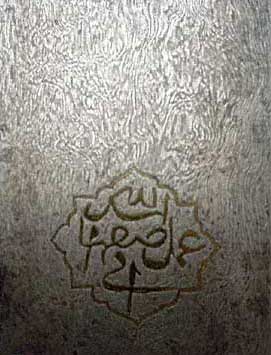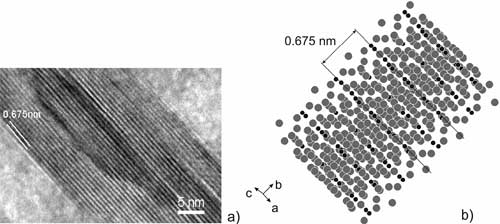| Posted: Nov 20, 2006 | |
Military nanotechnology (take 2): the secret of superior weaponry hundreds of years ago |
|
| (Nanowerk Spotlight) You might have seen our recent Nanowerk Spotlight on modern military nanotechnology (Military nanotechnology - how worried should we be?) and read about the hundreds of millions of dollars that the U.S. military pours into nanotech research every year. Well, it turns out that metalsmiths in India perhaps as early as 300 AD, and presumably with a much lower budget, developed a new technique known as wootz steel that produced a high-carbon steel of unusually high purity. Wootz, which are small steel ingots, was widely exported and became particularly famous in the Middle East, where it became known as Damascus steel. This steel had extraordinary mechanical properties and an exceptionally sharp cutting edge. The original Damascus steel swords were made possibly as early as 500 AD to as late as 1750 AD. What's so interesting about this? It turns out that the secret of Damascus steel is carbon nanotubes. Recently discovered in the nanostructure of a 17th century Damascus saber, the nanotubes could have encapsulated iron-carbide (cementite) nanowires that might give clues to the mechanical strength and sharpness of these swords. | |
 |
|
| Details of an inscription, probably the swordsmith's name, on a blade of Damascus steel | |
| The critical characteristic of wootz steel is the abundant ultrahard metallic carbides in the steel matrix precipitating out in bands, making wootz steel display a characteristic banding on its surface. Wootz swords were renowned for their sharpness and toughness and the medieval crusaders, with inferior swords, learned this the hard way when they battled Muslim armies. | |
| During steel making, impurities are added to control the properties of the resulting alloy. In general, notably during the era of Damascus steel, one could produce an alloy that was hard and brittle at one extreme by adding up to 2% carbon, or soft and malleable at the other, with about 0.5% carbon. The problem for a swordsmith is that the best steel should be both hard and malleable – hard to hold an edge once sharpened, but malleable so it would not break when hitting other metal in combat. This was not possible with normal processes. However, Damascus steel possessed these properties and it has become clear now that they are due to carbon nanotubes. European blacksmiths never managed to learn the secrets and copy the process. | |
| It is still not quite clear how the carbon nanotubes formed inside the steel blades. Professor Peter Paufler at the Institute for Structural Physics at the Technical University of Dresden in Germany thinks it is a combination of the forging process and the impurities contained in the wootz steel. At high temperatures the impurities in the Indian ores could have catalyzed the growth of nanotubes from carbon. | |
| "A sophisticated thermomechanical treatment of forging and annealing was applied to these wootz cakes to refine the steel to its exceptional quality" says Paufler. "We suggest that our finding could link the distinctive banding seen in Damascus blades with impurities contained in the steel. By empirically optimizing their blade-treatment procedure, craftsmen ended up making carbon nanotubes more than 400 years ago." | |
| The impurities that Paufler refers to are mentioned in early reports on Indian wootz production. Particular ingredients were mandatory — such as wood from Cassia auriculata, an evergreen Indian shrub with vivid yellow flowers whose bark is used in tanning, leaves of Calotropis gigantea, commonly known as milkweed or swallow-wort, and ores taken from particular mines in India. The ore deposits in these mines provided significant levels of certain trace elements, notably, Cr, Mo, Nb, Mn, or V (for a detailed discussion see "The Key Role of Impurities in Ancient Damascus Steel Blades"). | |
| One of the big mysteries of wootz Damascus steel has been why the art of making these blades was lost. An explanation could be the diminishing supply of some of these ores during the eighteenth century, which may have prevented blade smiths, who would not have been aware of the importance of these alloying elements, from practicing their ancient recipes. | |
| Paufler’s team has uncovered the presence of carbon nanotubes by exposing a small piece of a blade to corrosion by hydrofluoric acid, and examining the effects under a high resolution scanning electron microscope. In some remnants the researchers saw evidence of incompletely dissolved iron carbide nanowires, suggesting the nanotubes could have encapsulated the nanowires. | |
 |
|
| HRTEM image of an iron carbide nanowire encapsulated in carbon nanotubes(a). The fringes oriented along the longitudinal direction of the wire correspond to lattice planes. The lattice spacing d = 0.675 nm of (010) planes of the cementite structure is indicated in the model projection (b) for comparison. (Reproduced with permission from Wiley) | |
| In previous work, Paufler already examined the microstructure of a Damascus saber ("Microstructure of a genuine Damascus saber") and found evidence of cementite nanowires. | |
| The recent findings by Paufler and his colleagues were reported in Nature ("Carbon nanotubes in an ancient Damascus saber"). | |
|
If you are interested in reading more on the history of wootz steel and Damascus steel, there is quite a number of books |
|
 By
Michael
Berger
– Michael is author of three books by the Royal Society of Chemistry:
Nano-Society: Pushing the Boundaries of Technology,
Nanotechnology: The Future is Tiny, and
Nanoengineering: The Skills and Tools Making Technology Invisible
Copyright ©
Nanowerk LLC
By
Michael
Berger
– Michael is author of three books by the Royal Society of Chemistry:
Nano-Society: Pushing the Boundaries of Technology,
Nanotechnology: The Future is Tiny, and
Nanoengineering: The Skills and Tools Making Technology Invisible
Copyright ©
Nanowerk LLC
|
Become a Spotlight guest author! Join our large and growing group of guest contributors. Have you just published a scientific paper or have other exciting developments to share with the nanotechnology community? Here is how to publish on nanowerk.com.
